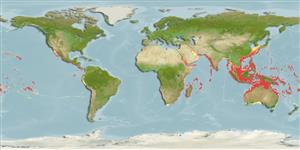>
Anguilliformes (Eels and morays) >
Muraenidae (Moray eels) > Muraeninae
Etymology: Gymnothorax: Greek, gymnos = naked + Greek, thorax, -akos = breast (Ref. 45335).
More on author: Rüppell.
Environment: milieu / climate zone / depth range / distribution range
Ökologie
seewasser riff-verbunden; tiefenbereich 0 - 150 m (Ref. 1602). Tropical; 35°N - 36°S, 19°E - 77°W
Indo-Pacific: Red Sea and South Africa (Ref. 3257) eastward to the Tuamoto and Austral islands, north to the Ryukyu and Hawaiian islands, south to New Caledonia. Eastern Pacific: Costa Rica, Panama and the Galapagos (Ref. 9324). Southeast Atlantic: South Africa.
Length at first maturity / Size / Gewicht / Alter
Maturity: Lm ?, range 65 - ? cm
Max length : 240 cm TL Männchen/unbestimmt; (Ref. 48635)
Rückenflossenstacheln (insgesamt): 0; Rückenflossenweichstrahlen (insgesamt): 0; Afterflossenstacheln 0; Afterflossenweichstrahlen: 0; Wirbelzahl: 132 - 140. Reddish eyes (Ref. 1602). Color yellowish, densely mottled with dark brown; front of head purplish grey; posterior margins of fins yellow-green; gill opening in a black blotch. Juveniles sometimes bright yellow with brown blotches (Ref. 48635).
Along drop-offs (Ref. 48635). Benthic (Ref. 58302). Occurs in coral or rocky areas of reef flats and protected shorelines to seaward reefs. Feeds on cephalopods (Ref. 30573), fishes, and crustaceans (Ref. 89972). Most often appears on the reef after a fish has been speared during daylight. The regularity and promptness of such appearances make it clear that G. flavimarginatus is especially sensitive to stimuli emanating from an injured or stressed fish (Ref. 13550). Eaten in some parts of the Indo-Pacific (Ref. 12484). Minimum depth reported taken from Ref. 128797. Solitary and curious, usually seen with head protruding (Ref 90102).
Life cycle and mating behavior
Geschlechtsreife | Fortpflanzung | Ablaichen | Eier | Fecundity | Larven
Chen, H.-M., K.-T. Shao and C.T. Chen, 1994. A review of the muraenid eels (Family Muraenidae) from Taiwan with descriptions of twelve new records. Zool. Stud. 33(1):44-64. (Ref. 6934)
IUCN Rote Liste Status (Ref. 130435)
Bedrohung für Menschen
Reports of ciguatera poisoning (Ref. 4690)
Nutzung durch Menschen
Fischereien: kommerziell; Aquarium: Kommerziell
Mehr Information
ReferenzenAquakulturAquakultur ProfilZuchtlinienGenetikElectrophoresesVererbbarkeitKrankheitenVerarbeitungNutrientsMass conversion
Tools
Zusatzinformationen
Download XML
Internet Quellen
Estimates based on models
Preferred temperature (Ref.
123201): 23.7 - 29, mean 27.8 °C (based on 1990 cells).
Phylogenetic diversity index (Ref.
82804): PD
50 = 0.5000 [Uniqueness, from 0.5 = low to 2.0 = high].
Bayesian length-weight: a=0.00035 (0.00024 - 0.00052), b=3.36 (3.25 - 3.47), in cm total length, based on LWR estimates for this species & Genus-body shape (Ref.
93245).
Trophic level (Ref.
69278): 4.2 ±0.72 se; based on food items.
Widerstandsfähigkeit (Ref.
120179): sehr niedrig, Verdopplung der Population dauert mehr als 14 Jahre. (Preliminary K or Fecundity.).
Fishing Vulnerability (Ref.
59153): Very high vulnerability (90 of 100).
Nutrients (Ref.
124155): Calcium = 14.6 [7.1, 24.7] mg/100g; Iron = 0.341 [0.190, 0.814] mg/100g; Protein = 18.9 [16.6, 21.5] %; Omega3 = 0.0968 [, ] g/100g; Selenium = 74.2 [35.8, 153.4] μg/100g; VitaminA = 38.1 [10.5, 142.9] μg/100g; Zinc = 0.716 [0.484, 1.021] mg/100g (wet weight);
